RFID Asset Tracking: All You Need to Know for Enhanced IT Asset Management
Helpful Summary
Overview: This article discusses everything you need to know about RFID asset tracking. We cover its importance in business management, and how you can take advantage of RFID asset tracking systems to streamline the entire asset management process of your business.
Why You Can Trust Us: As experts in asset management, we at BlueTally understand the challenges businesses encounter when it comes to asset management. Our expertise in asset management is the reason why we worked directly with Unilever, Pfizer, Vodafone, Warner Music Group, and other international companies.
Why It Matters: RFID asset tracking is crucial for any business because it provides precise, real-time tracking of assets which enhances decision-making, boosts efficiency, and improves asset utilization. This in turn can lead to significant business cost savings and operational improvements.
Action Points: We suggest you take advantage of BlueTally’s free trial session to get firsthand experience on how our asset management system can be helpful for your business.
Further Research: To complement this learning, we invite you to visit our website and read our blog to learn more about how BlueTally can be of assistance for your business asset management concerns.
RFID technology has come a long way since they were first used during World War II. Today, its market worth is set to hit $31.4 billion by 2029, which isn't surprising as RFID tech can be found almost anywhere.
One of the areas where we’re seeing more RFID use is in tracking business assets. Many companies are throwing out their asset spreadsheets in favor of an automated RFID asset tracking system.
Implementing an RFID tracking system will enable you to find out the real-time status of assets and help you keep on top of asset maintenance to increase operational efficiency. Asset information can be stored and controlled using asset management software like BlueTally.
In this article, you can learn more about RFID asset tracking technology and how opting for an automated RFID tracking system like BlueTally can take your business asset management to the next level.
Why Listen To Us?
In tackling RFID asset tracking, BlueTally has provided robust solutions across various sectors. We have helped businesses like Unilever, MSC, Warner Music Group, Pfizer, and other international brands improve customer satisfaction and inventory visibility through RFID technology, streamlining their asset management and eliminating inefficiencies.

By integrating BlueTally’s advanced RFID systems, businesses can effectively keep track of their assets which helps reduce operational costs, improve inventory accuracy, and enhance operational efficiency.
What is RFID Asset Tracking?
First, we'll review what RFID asset tracking is and how it can benefit your company.
An RFID (radio frequency identification) asset tracking system uses radio waves to identify assets. An RFID tag transmits identifiable data on an asset via radio waves back to an RFID reader when scanned. The data stored on a tag includes a unique asset ID and other distinctive information represented as a number. The numbers point to the corresponding information kept in the database of a secure asset register like BlueTally.
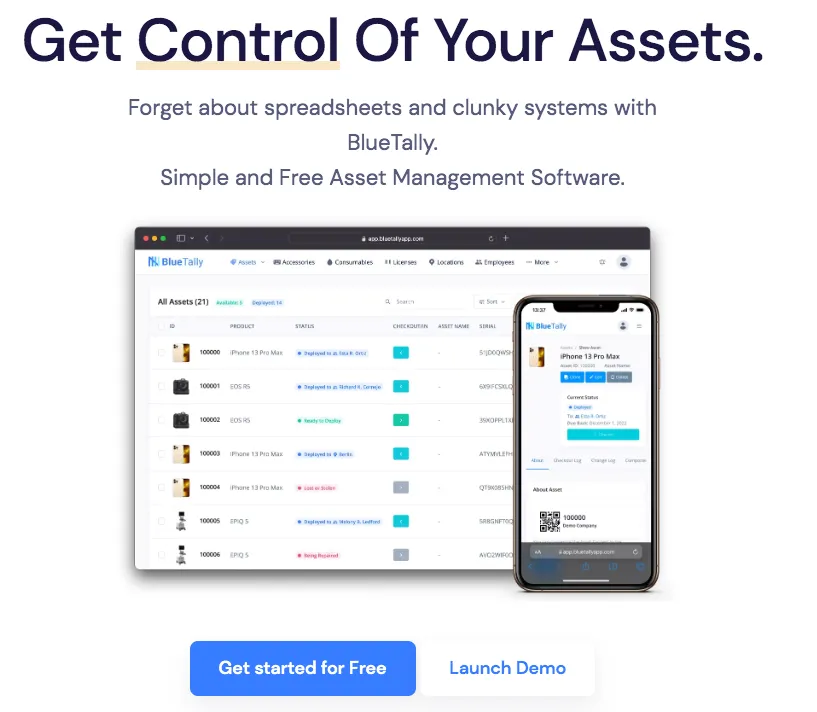
Why RFID Asset Tracking Is Important?
RFID asset tracking can benefit your business regardless of its size, and here are some reasons why.
Data Accuracy, Time, and Money Saved
An RFID tracking system is a cost-effective, quick, and dependable way to track and manage assets without mistakes. The technology can be configured to automatically track asset movements and changes while keeping the asset register updated. With minimal manual intervention required, resources can be utilized elsewhere.
Increased Revenue
An RFID asset tracking system allows you to keep your assets in optimal working condition with scheduled maintenance. Less downtime and longer-lasting assets will contribute to a healthy bottom line, as you’ll be able to reduce costs relating to maintenance and repairs.
Increases Asset Visibility
You can quickly find misplaced items, stop items from going missing, and prevent duplicate purchasing by knowing how much you have of each asset. Cloud-based asset management systems like BlueTally offer a comprehensive dashboard with an asset status overview and detailed life cycle information accessible company-wide.
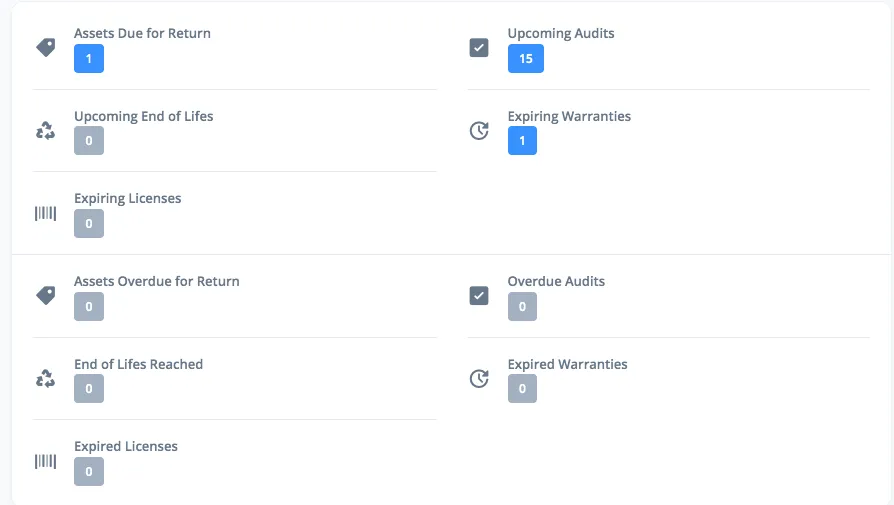

Enhance Asset Security
RFID technology enhances the security of assets by providing a way to track and monitor their movement. For example, you can use RFID tags to track the movement of all your physical business assets within a secure facility.
This tracking capability can help prevent theft or unauthorized access to assets, as any movement of the assets can be monitored and recorded, increasing overall security measures.
Improve Overall Customer Service
RFID technology can improve your customer service by ensuring the availability of products and timely delivery.
Let’s take a retail store as an example.
The business owner can start using RFID tags to track and monitor inventory and automatically reorder products that are running low on stock.
This will ensure that the store will not run out of the items that people are looking for, which can lead to a higher customer satisfaction rate and loyalty.
Enhance Decision Making
RFID asset tracking enables business owners to make better decisions in day day-to-day basis.
With access to real-time data, businesses will have a better grasp of how operations are going. This way, you can make informed decisions on how to optimize your production process, reduce lead times, and improve overall business operation efficiency.
Different Types of RFID Asset Tags and RFID Asset Tracking Systems
Types of RFID Asset Tags
Active RFID Tags
Active RFID Tags have their own power source (an internal battery) and can actively broadcast their signal to RFID readers. They typically have longer read ranges and can broadcast radio waves and transmit data to a reader up to 150 meters away.
Active RFID tags are often used for tracking high-value assets over large areas, such as in shipping and logistics.
Semi-Passive RFID Tags
Semi-Passive RFID tags (also known as Battery-Assisted Passive, Semi-Passive tags) are a hybrid of active and passive tags. They have a small battery that powers the tag's circuitry, but they still rely on the RFID reader to provide power for communication.
Semi-passive tags have longer read ranges than passive tags (up to 100 meters) but are shorter than active tags. They are often used in applications where a longer read range is required, but the battery life of an active tag is not necessary.
Active and semi-passive tags are the preferred choice for more expensive items. They offer real-time tracking for an accurate real-time location system (RTLS).
Passive RFID Tags
On the other hand, passive RFID tags are powered by electromagnetic signals sent from the RFID reader and not an internal power source. They can read up to 20 feet away, are small, and are relatively cheap to make. For these reasons, they are common in companies with a significant physical asset inventory.
The two most common types of passive tags are inlays and hard tags. Inlays are the more economical option and are usually attached to the asset. Hard passive tags are rugged and best for assets in high temperatures and adverse weather.
Types of RFID Asset Tracking Systems
Handheld RFID Reader-Based Systems
Handheld-based readers accommodate faster auditing and discreet RFID tags. It offers distance scanning without needing a line of sight, so it’s ideal for scanning assets to verify that they're in the location they’re supposed to be. In addition, a handheld reader can connect to your smartphone through BlueTooth, so you can read RFID tags using your phone.
Fixed RFID Asset Management
Fixed RFID asset tracking offers automated location tracking of your assets. Here you can position your RFID readers in strategic areas throughout your site, and anytime RFID tags come in contact with a fixed reader's radio frequency field, it will detect the asset and analyze where it’s going.
Examples of RFID Asset Tracking Uses
Most assets can be tracked using RFID tech. Here are how some industries use RFID systems to track valuable assets successfully.
Education - RFID asset tracking systems are prevalent in education and are mainly used to prevent school property from loss and theft.
Healthcare - Hospitals utilize active and passive RFID, RTLS, and Wi-Fi systems to track high-value equipment and patients for admission and placement purposes.
Construction - With RFID asset tracking systems, construction businesses can efficiently keep track of every asset that is on-site and its location. This helps manage inventory, prevent theft, and make sure the right people and things are in the right place. It also helps with safety by controlling who can access the construction site.
Non-Profit Activities - RFID can help non-profit organizations manage donations, track goods more efficiently, as well as manage events and keep track of who attends. Moreover, an RFID tracking system can also be useful in tracking non-profit assets like vehicles and equipment. Overall, RFID helps non-profits work better and serve their communities more effectively.
Manufacturing - Manufacturing companies may use RFID tech for their smaller assets, like work tools, to large assets, like shipments.
IT - IT companies will tag things like their computers and laptops to identify each item throughout its life cycle. All asset information is stored in a database or via asset management software to find real-time information, including the asset's location, current owner, and maintenance history. Or it may be used in employee IDs to allow authorized access to secure areas.
How to Choose the Best RFID Asset Tracking System
1. Define Your RFID System Objectives
Consider discussing with your team what you expect to achieve by implementing an RFID asset tracking system. How will it meet the business requirements? Establish what assets will be tracked and the type of information you need to capture. Defining and agreeing on the system's objectives with stakeholders will create boundaries, give the implementation process direction, and help decision-making.
2. Understand the Tracking Environment
Is your tracking environment indoor or outdoor? The radio signals used to communicate between the tag and tracking system can be prone to interference. Thus the selected technology should be able to handle the challenges that come with it. For example, a typical indoor environment with electronic equipment, large amounts of metal, and people can weaken signals through absorption.
On the other hand, radio signals can be weakened through dispersion and absorption by trees, buildings, and various weather conditions. Tags with dual-mode capability can be used in different environments if you want to track assets indoors and out.
3. Tag Size and Read-Range
The tag size matters as it usually correlates to the read range. Passive RFIDs are more common. However, they come in several shapes and sizes, so you will likely find a size to fit your requirements.
4. Find Out the Operating Frequency Required
RFID tags are categorized at the frequency they are designed to operate, for example:
- Low Frequency (LF): This cost-effective method has a low read range and slow processing speed. It's a good choice for permanently tagged items and close-range reading apps. Plus, LF readers are not affected by environmental factors.
- High Frequency (HF): This type offers better tag and reader placement flexibility thanks to its higher read range, accuracy, and faster processing.
- Ultra-High Frequency (UHF): UHFs offer a read range of up to 25 feet and can scan truckloads of tagged assets simultaneously. However, they are more susceptible to disruption from their surroundings.
5. Cost
The cost will play a significant factor in your decision. Perform an analysis of the fees against whether the technology will meet the business requirements and objectives established in step one.
For instance, if you want a passive RFID system, you'll need to factor in the reader, cabling, and antenna costs. And to achieve location granularity, you'll need a dense network of readers. In addition, this setup is typically powered over Ethernet (POE) to passive RFID devices, which will increase overall equipment costs.
On the other hand, the kit required for an active RFID asset tracking system is significantly cheaper. Here are some additional costs that you'll need to factor into your budget:
- Installation costs - passive RFID systems must be installed by an expert.
- Tag costs - the active RFID tags cost more than the passive tags, and battery maintenance will cost extra.
- Ongoing license costs - passive RFID tech typically requires ongoing license costs for software upgrades and support.
Best Practices When Using an RFID Asset Tracking System
Whether it's tracking inventory in a warehouse or managing equipment in a construction site, RFID technology offers better efficiency and accuracy.
However, to make the most of an RFID asset tracking system, , below are some key guidelines to consider:
Tag Placement: Place RFID tags on assets where they can be easily scanned and are less likely to be damaged. Tags should be placed in a location that is easily accessible for scanning, such as on the surface of an asset or attached with a durable adhesive.
Tag Encoding: Encode RFID tags with unique identifiers and relevant information. Each tag should have a unique identifier that distinguishes it from other tags. Additional information, such as asset type or location, can also be encoded onto the tag.
Reader Placement: Position RFID readers strategically for optimal coverage. Readers should be placed in locations where they can effectively read tags on assets passing through or nearby. Consider factors such as the read range of the reader and potential interference from other objects.
Data Integration: Integrate RFID data with existing systems for comprehensive asset tracking. RFID data should be integrated with other systems, such as inventory management or asset management software, to provide a complete view of asset location and status.
Regular Maintenance: Conduct regular maintenance checks on RFID equipment to ensure optimal performance. Check RFID tags and readers for damage or malfunction regularly. Replace or repair any faulty equipment to maintain accurate tracking.
By following these best practices, you can maximize the effectiveness of your RFID asset tracking system and improve overall asset management efficiency.
Benefits of Using BlueTally as Your RFID Asset Tracking System
Let’s take a look at the core features that make BlueTally a robust solution for asset management, enhancing the control and oversight of your business assets.
Real-Time Asset Tracking
BlueTally's real-time asset tracking lets businesses constantly monitor the location and status of their assets. This access to immediate data is vital for quick decision-making and addressing asset issues quickly, which helps cut downtime and boost operational efficiency.

Barcode and QR Code Integration
The BlueTally asset tracking system integrates with barcode and QR code technologies that simplify the processes of asset registration and tracking. Through barcode and QR code scanning, you can quickly register, track, and audit your assets, enhancing the speed and accuracy of inventory management while reducing human error.
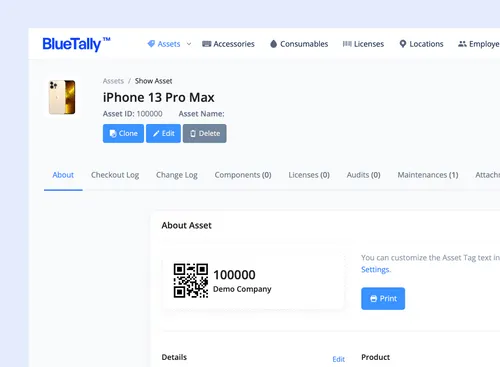
Integration with Major Systems
BlueTally integrates seamlessly with platforms like Microsoft Intune, Azure AD, and Jamf for smooth data synchronization across various business systems. By linking with these major systems, BlueTally ensures that your asset data is consistently updated and accurate, enhancing overall asset management and compliance. Read more about our integrations here.
Customizable Alerts and Reporting
BlueTally’s customizable alerts and detailed reporting capabilities allow you to set alerts for specific events such as asset audits, maintenance needs or unauthorized asset movement. These features are great for helping you proactively manage your assets by staying informed about critical updates and generating reports that aid in strategic planning and audit processes.
Scheduled Maintenance Tracking
Scheduled maintenance tracking is a key feature of BlueTally. This feature enables the planning and recording of maintenance activities for each asset which helps you extend the lifespan of your business assets and avoid unexpected breakdowns, effectively reducing operational disruptions and maintenance costs.
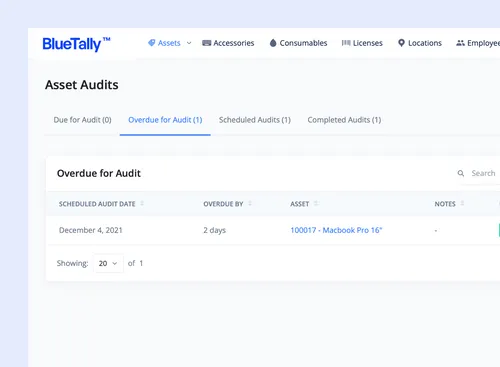
Comprehensive Asset Database
With a comprehensive asset database, BlueTally supports detailed recording of each asset, including purchase details, condition, history, and depreciation. This feature aids in financial and compliance reporting, ensuring that all asset information is accurately tracked and readily available for audits or strategic decision-making.
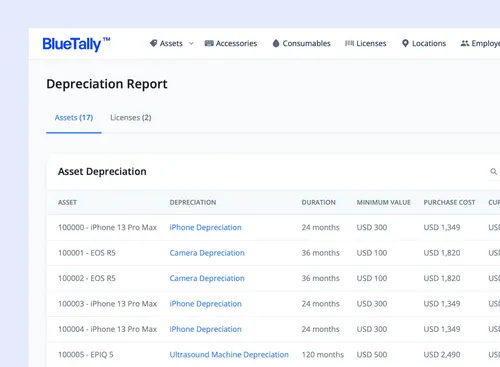
User-Friendly Interface
BlueTally offers an intuitive and easy-to-navigate interface designed to simplify the management of assets without a steep learning curve. This user-friendliness ensures that all users, regardless of technical background, can efficiently utilize the system and supports effective asset-tracking efforts.
Conclusion
Using RFID technology to manage your IT assets can benefit your business in so many ways. It allows you to know their whereabouts at any time, helps you to maximize the value of your assets by keeping on top of maintenance, and sends accurate updates and real-time information straight to your asset management system.
By implementing BlueTally's RFID asset tracking system, you can streamline your entire asset management to improve your asset security, decrease operation downtime, and establish better compliance with industry standards.
With its user-friendly interface and robust features, BlueTally empowers businesses to optimize their asset management practices effectively.
If you're ready to see why so many large and small businesses use BlueTally software to manage their assets, explore our demo and try BlueTally for free today and take your asset management to the next level!






